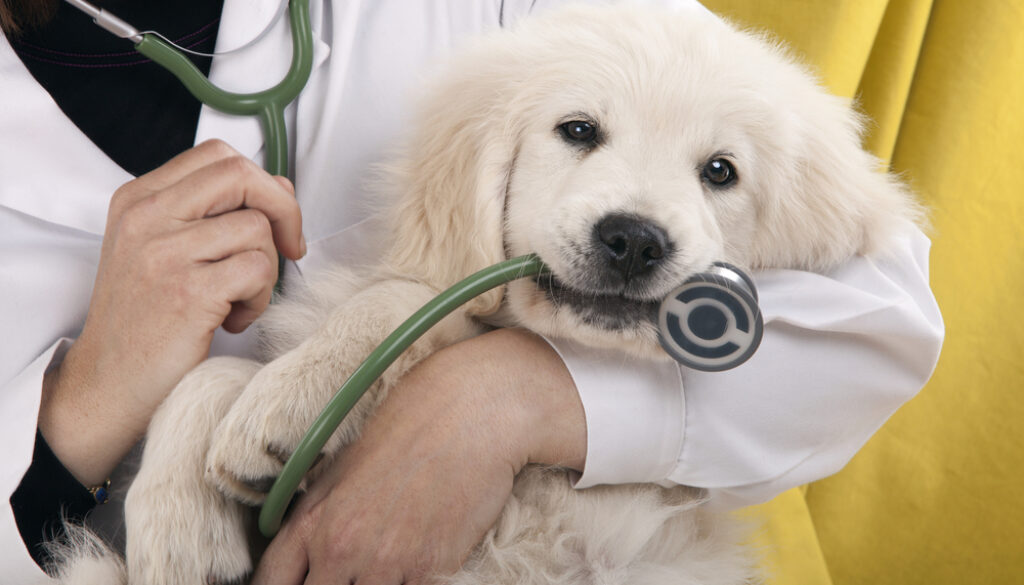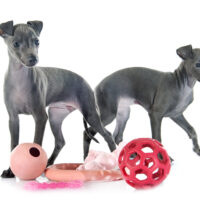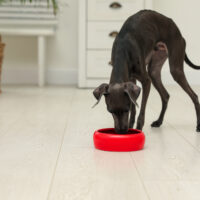Dog Health In The Office & Finding Hazards

Maintaining dog health in the office involves creating a safe and comfortable environment. This starts with identifying and mitigating potential hazards. Common workplace dangers include toxic plants, loose electrical cords, and small objects that dogs might ingest. Stairways, entrances, and other high-traffic areas should be secured to prevent accidents.
Providing a designated resting area, access to fresh water, and regular meal times ensures dogs’ basic needs are met. Regular exercise breaks and outdoor access help keep dogs physically active and mentally stimulated. Additionally, it’s important to maintain office hygiene by cleaning up pet hair and dander, which can affect both dog and human health. By proactively addressing these hazards and fostering a dog-friendly environment, you can ensure the well-being of dogs in the workplace while maintaining a productive and harmonious office atmosphere.
Many organizations have adopted pet-friendly policies to encourage employees to return to the office, leading to a healthier work environment and attracting top talent. One notable example is Google, where employees, affectionately known as Dooglers, regularly bring their dogs to work. This practice began in 1999 with Yoshka, the first recorded dog to visit and work inside the Google office, enhancing the overall work experience.
What do we mean by Dog health in the office?

Dog health in the office refers to the well-being of dogs that accompany their owners to the workplace. Ensuring good dog health in an office environment involves several factors such as being free for hazards, Having traffic comfortable areas, access to fresh water, regular exercise, good hygiene, and be well socialized.
Modern workplaces and homes can be unfamiliar and challenging environments for both puppies and older dogs. Unless you have easy access to a garden or a local park, these settings typically lack natural elements like trees, grass, wind, and rain. Domestic dogs must adapt to these new surroundings, which can be a difficult process.
However, you can help make your dog’s transition smoother and ensure their safety. Hazards exist throughout the workplace, from the entrance to the stairs connecting your office.
Stairs
Stair gates are a great addition to workplaces with multiple dogs or pets. Ensure that all colleagues and clients are aware of the need to close the gate when entering and leaving. Additionally, confirm that your workplace approves the installation and that it meets all health and safety regulations. The last thing you want is your dog running through an open stair gate and out the front entrance, potentially into traffic. It is advisable to keep an eye on your dog at all times to minimize the risk of escape.
Windows and doors
Some windows at work have a restrictor, others open up very wide. Be mindful if your dog likes napping by the window. Some dogs can overreact if they see a cat or other cute animal while they are sleeping. The dog’s Instinctive nature could kick in and the dog may forget about in-the-moment safety and jump down a few storeys
Should Dogs be allowed in the kitchen?
We all love the kitchen for that well-needed gossip, break, or work coffee. But there is a bunch of potential hazards in the kitchen which will need to be addressed before you bring a new dog in. Some dogs can open cupboards with their noses and others can use their paws; especially if they know there is something tasty inside. Consider child-proofing the cupboard doors with locks or keeping the chemicals higher up out of reach, just remember to inform the cleaner.
Just like humans, If a pet digests chemicals, it can be fatal. Some chemicals include bleach, washing detergent, sprays, dishwasher tablets and even oven cleaners. Keep them in locked cupboards or high up out of reach. Don’t rely on the child safety caps as they are no match for a jaw full of canine teeth!
Some dogs love nothing more than to raid the bin for an extra snack, so make sure the bin has a lid. Some dangers in the bin include bones, packaging, toxic food such as grapes, chocolate and even mouldy food. Dogs may also tear the bin apart and cause a mess.
Dog health can be defined as the state of a dog’s full physical, mental, social, psychological, emotional and social well-being.
Like other higher animals, Dogs can be affected by changes in environments and people/pets around them. They can tend to fall below their functioning capacity.
- Co-workers: Before taking your dog to the office, it’s essential to make sure that no one has allergies to dogs. And that no one is afraid of them. Also, make sure your manager allows pets. If co-workers aren’t happy with your canine best friend for some reason, this will just cause distractions all around. Not following these points may result in a negative office atmosphere, that could last a long time. This may be frustrating and have an effect on everyone involve, including your favourite canine.
- Type of dog: Achieving the dream of getting hired at a place that allows dogs is amazing. But be sure to find the right type of dog, as not all dogs can be office friendly.
Usually, the best breeds for the office are the ones weighing less than 10 KG and enjoy spending time under a desk. Also consider their noise level and overall temperament. Here are some breeds that snuggle up at your feet while you work.
‘What to’ and ‘What not to feed your dog while in the office
Just as parents disagree on questions of nutrition and raising their children, there are also different approaches to dog nutrition among dog owners.
A Dogs food intake depends on how active the dog is and its weight, Around 57kcal of food should be fed daily for every KG. But this can vary greatly, it is also dependent on the stage of your dog’s life – puppies, breeding bitches, young dogs or old dogs.
Nutrition options for dogs in the office include;
Dried animal food: This classic dry dog food offers several advantages, e.g. it guarantees practical storage, makes little mess and is cheap to buy. It’s best to take 10% less than the manufacturer says.
Canned /wet dog food: This dog food is easy to store and practical when travelling, especially to the office. Sometimes it is mixed with other essential vitamins, and usually processed from meat waste, such as kidneys, lungs, and rumen of animals. It’s also usually smellier than the dried variety.
Homemade dog food: The advantage of this is that you prepared it. Meaning you know exactly what is inside. But it’s usually time-consuming. The rations should consist of meat, vegetables and a side dish with no spices. If your dog has a food intolerance, homemade food is usually superior because you can monitor exactly how the dog reacts to what you give him. You can also make dog biscuits, just don’t get them confused and give them out to colleagues.
Vegan and vegetarian diet: This ethical choice is growing in popularity, but vitamins and minerals will usually have to be supplied via other means to avoid deficiency.
Harmful foods for your dog in the office:

- Chocolate: Humans love chocolate but it’s extremely toxic for dogs and should be avoided at all costs. Chocolate contains substances that dogs cannot break down. So keep your chocolate out of reach or locked in a draw!.
- Grapes and Raisins: Grapes and Raisins can cause kidney failure in dogs, so it’s a good idea to avoid this fruit!
- Onions
- Raisins
- Red beans
- Avocado: Avocado is also a popular lunchtime treat for humans, but for dogs, it’s very toxic. Persine is a chemical found in avocados which can cause vomiting, diarrhoea, and myocardial damage in dogs.
- Onion and Garlic: Onion and Garlic are bad for dogs; whether it’s cooked or raw. If dogs eat onions and garlic they can get anaemia.
- Raw potatoes in large quantities
- Fruit kernels
- Christmas baking
- Cereals (as some dogs are gluten-intolerant)
Plants and flowers that dogs should avoid in the workplace
It’s common knowledge that dogs sometimes like to eat grass and this isn’t something to be concerned about. But some dogs take a bite out of plants, especially if the human gives the plant attention. Some plants can be toxic to pets so make sure that your dog doesn’t get access to them. The most common ones include lilies, aloe vera, poinsettia, rubber tree plants and chives.
Symptoms of poisoning from ingesting toxic house plants range from sickness and diarrhoea to difficulty breathing and even death. Below is a list of toxic plants in alphabetical order:
| A | ||
| Amaryllis | Aquilegia | Autumn Crocus |
| Angel’s trumpet | Alfalfa | Avocado |
| American Mistletoe | American Elder | |
| B | ||
| Buxus | Boom Snakewood | Blue Flag Iris |
| Black Walnut | Bracken | Bulbous Buttercup |
| Black Locust | Black-eyed Susan | Black nightshade |
| C | ||
| Caladium | Chrysanthemum | Croton |
| Corydalis | Crocus | Cyclamen |
| Candelabra-cactus | Common hop | Canada Nettle |
| Common Privet | Cardinal flower | California Canarygrass |
| Chinese-lantern | California Rose-baby | Castor-bean |
| Climbing nightshade | Canada Yew | Common Vetch |
| Cocklebur | ||
| D | ||
| Devils-backbone | Daffodil | |
| E | ||
| English Ivy | English Bluebell | English Holly |
| European Elder | ||
| F | ||
| Flamingo Lily | Foxglove | Fly Honeysuckle |
| False Hellebore | ||
| G | ||
| Golden-Trumper | Garlic | Giant Hogweed |
| Garden Sorrel | Greasewood | Golden-Bean |
| Guelder-Rose | ||
| H | ||
| Heliotrope | Hydrangea | Horse Chestnut |
| I | ||
| Iceland Poppy | ||
| J | ||
| Jimsomweed | Jerusalem-cherry | Johnson Newfoundlands |
| Japanese Wisteria | ||
| K | ||
| Kaffir Lily | Kentucky Coffeetree | |
| L | ||
| Lily-of-the-valley | Larkspur | Large-leaved lupine |
| M | ||
| Monk’s Hood | Mother-in-law-plant | Morning Glory |
| Motherwort | Mango | Moonseed |
| N | ||
| Narcissus | ||
| O | ||
| Onion | Oleander | Oriental Poppy |
| Opium Poppy | ||
| P | ||
| Peruvian Lily | Pawpaw | Poison-hemlock |
| Poinsettia | Purple Locoweed | Philodendron |
| Pokeweed | Ponderosa Pine | |
| R | ||
| Red Maple | Reed Canarygrass | Red Oak |
| Radish | Red Clover | |
| S | ||
| Smooth Pigweed | Sun Spurge | Sneezeweed |
| Sunflower | Spatulate-leaved | St.John’s Wort |
| Sheep-laurel | Sweet Pea | Silvery Lupine |
| Small Lupine | Silky Lupine | Swiss-cheese Plant |
| Sensitive Fern | Star-of-Bethlehem | Solomon’s Seal |
| Siberian Scilla | Skunk Cabbage | Stinkweed |
| Stinging Nettle | ||
| T | ||
| Tree-of-heaven | Tall Manna Grass | Tobacco |
| Tansy Ragwort | Thin-leaved Snowberry | Tansy |
| Thuja | ||
| V | ||
| Velvety Goldenrod | Virginia Creeper | |
| W | ||
| Wild Indigo | White Sweet Clover | White Oak |
| Wild Radish | Western Poison-oak | Wild Mustard |
| White Clover | White Camas | |
| Y | ||
| Yellow Rocket | Yellow Iris | Yellow Toadflax |
| Yellow Sweet Clover |
Why is my dog sick while in the office?
When dogs are in pain or don’t feel well, dogs tend to display behavioural changes. Usually, these personality changes occur suddenly. Your social dog may become anti-social. Your kind and the energetic pet may begin to show snippiness, aggression or lethargy.
What Dog health issues may arise in the office?
Diarrhoea: If your dog has persistent constipation or diarrhoea that lasts for more than 48hrs or there is blood or mucus, it is recommended that you go see a veterinarian.
Repeated vomiting, gagging, sneezing or coughing: Persistent sickness or choking when eating is a concern. Vomiting can be a sign of a developing allergy or a more serious infection, particularly in older dogs. Kennel cough can also be a serious contagious illness.
Refusal to eat for over 24hrs: For a range of reasons your dog’s eating patterns may occasionally become irregular. But if your dog refuses to eat for a day or more consult your vet.
Excessive thirst or urination– unusually excessive thirst and frequent urination is a common signs of illness.
Red or swollen gums: Reddened or swollen gums, particularly when associated with bad breath, are an indication of gum disease. When severe, dogs may lose their teeth, drop food from their mouth and suffer weight loss due to difficulty eating.
Difficulty urinating: Look out for yelping when urinating, a hunched back or blood in the urine.
Runny eyes or nose: Sneezing, panting, runny eyes and nose or other flu-like symptoms may be signs of respiratory problems, as are gasping or shortness of breath.
Itchy, flaking skin: skin condition is a good general indicator of health. The skin should be smooth and pink or black. Persistent itching, sores, lumps and signs of dermatitis could indicate an allergic reaction to flea bite.
Progressive changes in weight: You should be concerned if your dog appears to lose weight progressively over 2 or 4 weeks, or shows a slow but steady weight loss over a longer period. Unexpected weight gain could be a sign of a problem.
General lethargy, tiredness: Just looking unwell or out of his/her normal healthy active self, please consult a vet.
Toys for your dog in the office
Not all dogs will require quite so much stuff, but if you want your fluffy friend to be happy you will probably end up packing a huge bag!
Here are some suggestions on what you could pack to ensure you are ready for almost anything that office life throws your way:
- Lead, harness and a collar with an ID tag
- Poop bags
- A mat or dog bed
- Food
- Good boy dog treats; for rewarding perfect behaviour
- A collapsible water bowl
- Some disinfectant spray and kitchen roll, just in case of accidents or muddy paws.
- A coat if they need one for the commute or break times.
- Food puzzle to distract your canine companion.
Other pets
Dogs can take a while to adapt to a new environment, this can take a longer amount of time when other pets are sharing the workplace such as cats. In the beginning, when taking your workplace pet to work, it can take a while for your dog to feel comfortable and adapt to the new surroundings.
Your pup may feel anxious about starting work and this is natural. The best way for dogs to overcome this feeling is to consistently familiarise themselves over a long period of time in a controlled manner. Don’t force your dog to meet other pets in the office, should your dog feel stressed move your pet back to its comfort zone.
Dog Health In The Office is important. Now you know what you need to have a successful office outing with your dog. Read up on your office pet policy (here are some rules we put together). Now start working on your dog training, pack some healthy dog treats and get ready for a fun working environment at the office.


